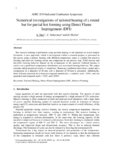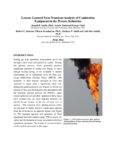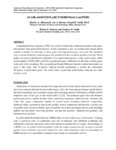TO
| Title | Date | Subject | Description | ||
|---|---|---|---|---|---|
| 226 |
 |
Fischer Assay Data, Utah Geological Survey Well Number U554 | 2008 | This dataset contains the results of Fischer assay analyses obtained and published by the Utah Geological Survey for well U554. | |
| 227 |
 |
Fischer Assay Data, Utah Geological Survey Well Number U162 | 2008 | This dataset contains the results of Fischer assay analyses obtained and published by the Utah Geological Survey for well U162. | |
| 228 |
 |
Fischer Assay Data, Utah Geological Survey Well Number U116 | 2008 | This dataset contains the results of Fischer assay analyses obtained and published by the Utah Geological Survey for well U116. | |
| 229 |
 |
Hardening of arehes for commercial simulation of industrial flares | With funding from the Department of Energy (DOE), to further the use of government funded high-performance computing (HPC) software for engineering analysis of industrial problems, Reaction Engineering International (REI) is working with the University of Utah to leverage the Uintah Computational Fr... | ||
| 230 |
 |
"Regulatory and analyzer update for USEPA's new formaldehyde emissions limit for combustion turbines" | 2019 | Spectrum's technical team has demonstrated a <27 ppbvd Formaldehyde detection limit (DL) on its extractive FTIR equipped using a 5-meter cell pathlength. This formaldehyde detection is well below USEPA's 91 ppbvd emission threshold for Combustion Turbines now subject to regulation under NESHAP Subpa... | |
| 231 |
 |
Closed loop flare control using a video imaging spectral radiometer | Video Imaging Spectral Radiometry (VISR) has emerged as the only practical method to directly and continuously monitor flare performance. The VISR method provides real time measurements of flare combustion efficiency (%) and a smoke index (0-10) at a 1-sec temporal resolution. In addition to these t... | ||
| 232 |
 |
Data informed multipoint ground flare evaluation using measurement and theory | This paper will explore the comparison of experimental (PFTIR) and simulation data obtained from assisted multipoint ground flares operating at high turndown. The flare assist is intended to encourage air entrainment for best combustion efficiency as well as reduce visible smoke. Operational envelop... | ||
| 233 |
 |
Numberical and experimental investigations on an innovative, regeneratively heated radiant tube with compact dimensions | 2019 | heat treatment; radiant tube; regenerative heating; staged combustion | The presented, public funded research cooperation project of the Department for Industrial Furnaces and Heat Engineering at the RWTH Aachen University and the WS Wärmeprozesstechnik GmbH main aim is the development of an innovative, regeneratively heated radiant tube with compact dimensions. The ma... |
| 234 |
 |
EC sensor: flame safety and fuel savings integrated into one system | Safety is the most important consideration in the operation of any combustion system. To that effect, operators of combustion equipment monitor the presence of a flame in various ways. The most common flame monitoring sensors include flame rods, infrared scanners and ultra-violet scanners. Although ... | ||
| 235 |
 |
Predicting Ash Deposition During Oxy-Coal Combustion | An ability to predict and control ash deposition are crucial to effective heat extraction from pulverized fuel (pf) units. Computation Fluid Dynamic (CFD) simulations in conjunction with fuel characterization data have been used in recent years to develop sub-models to predict slagging propensities ... | ||
| 236 |
 |
PERF Project 2014-10 Results and Analysis of the VISR Method for Remote Flare Monitoring | 2019 | The Petroleum Environmental Research Forum (PERF) is a non-profit organization created to provide a stimulus to and a forum for the collection, exchange, and analysis of research information relating to the development of technology for health, environment and safety; waste reduction; and system sec... | |
| 237 |
 |
Neutron imaging of heterogeneous solid fuels under heating | 2019 | Solid-fuel pyrolysis, gasification, and combustion continue to play an important role in the industrial and utility sectors. Behavior of heterogeneous fuels such as biomass (e.g., wood and grasses), municipal solid waste (MSW), and coal is less understood on the micro than the macro scales, particul... | |
| 238 |
 |
Numerical investigations of tailored heating of a round bar for partial hot forming using Direct Flame Impingement (DFI) | 2019 | Tailored Heating; Direct Flame Impingement (DFI); Massive Forming | Hot massive forming is performed using uniform heating of the materials to avoid wrinkle formation. A new approach, which is investigated within a research project, is presented in this paper, using a tailored heating with different temperature zones to conduct hot massive forming and semi-hot formi... |
| 239 |
 |
Lessons learned from transient analysis of combustion equipment in the process industries | During gas flare operation, hydrocarbon gas is fed through a flare stack and ignited by a pilot. During the ignition process, flares generally produce significant amounts of smoke (see Figure 1) since enough mixing energy is not available to entrain surrounding air to completely burn the flare gas. ... | ||
| 240 |
 |
An air-assisted flare for biomass gasifiers | 2019 | Computational fluid dynamics (CFD) was used to simulate the combustion practice of the gases that produce from gasification process. In this simulation a new air-assisted flare design which capable to handle low flowrates of these gases with high performance was used. The simulated cases were perfor... | |
| 241 |
 |
Comparison of laboratory and field steamfloods in tar sand | In situ recovery technologies for tar sand and heavy oil are simulated at the Western Research Institute to prepare for pilot tests and commercial operations. Wide ranges of process parameters are tested in one-dimensional reactor tubes in which the tar sand or heavy oil is uniformly reconstituted t... | ||
| 242 |
 |
A comprehensive parametric investigation of efficient soot modeling using high fidelity method of moments | PSD; PAH; nucleation; Soot; Radiation; Method of moment | Soot is one of the most regulated pollutants in all the combustion applications like automotive engines, aviation engines, and industrial furnaces. Modeling soot formation is quite challenging due to the complex processes involved in the formation of the soot particulates. Empirical formulation base... | |
| 243 |
 |
Design Considerations for Carbon-Free Combustion | Decarbonization; Hydrogen Combustion; Carbon Dioxide; Carbon-Free Combustion; CO2 Emissions; Greenhouse Gas Emissions | Combustion of a hydrocarbon produces water and carbon dioxide. As consensus continues to build around the contributions of carbon in global client change, jurisdictions, both internationally as well as domestically, are working towards limiting formation of carbon dioxide. One way to work toward eff... | |
| 244 |
 |
Flare combustion index in lieu of combustion zone net heating value | 2020 | Flares are commonly used at industrial facilities (e.g., oil and gas extraction and production sites, gas processing plants, oil refineries, and petrochemical manufacturing plants) to safely dispose of process waste gases. Waste gases may be produced due to process upset or because they are unrecove... | |
| 245 |
 |
Advanced emissions monitoring from elevated gas flares for early warning system and optimization of plant operations | 2019 | Real-time monitoring of emissions from elevated gas flares is very difficult and expensive due to the relative location of the source and the cost to collect samples for analysis. Elevated Analytics has developed and applied a UAV based sensor system to accomplish this task. Besides providing a snap... | |
| 246 |
 |
3D CFD model development and validation for once-through steam generator (OTSG): coupling combustion, heat transfer | The current research studies the coupled combustion inside the furnace and the steam generation inside the radiant and convection tubes through a typical Once-Through Steam Generator (OTSG). A 3D CFD model coupling combustion and two-phase flow was developed to model the entire system of OTSG. Once ... | ||
| 247 |
 |
ClearSign eye™: pilot sensor | Clearsign Technologies Corp. has developed and tested a novel, capacitive based flame sensor for use on existing burners in a variety of industrial combustion applications including process burners, boiler burners and flares. ClearSign has developed two probe designs. The first probe design is compa... | ||
| 248 |
 |
Fluidized bed pyrolysis of bitumen-impregnated sandstone at sub-atmospheric conditions | 1993-05 | fluidized bed pyrolysis; bitumen-impregnated sandstone; sub atmospheric conditions | A 15.2 cm diameter fluidized bed reactor was designed, built, and operated to study the pyrolysis of oil sands at pressures slightly less than atmospheric. Fluidizing gas flow through the reactor was caused by reducing the pressure above the bed with a gas pump operating in the vacuum mode. Pyrolysi... |
| 249 |
 |
Final report on 1989 update of the computerized geologic model to include the 1988 drill hole data Sunnyside Tar Sands project Sunnyside, Utah | 1989-07 | computerized geologic model; 1988 drill hole data; Sunnyside Tar Sands project; geologic resources | In May 1989, Rozelle Consulting Services (RCS) was requested by Amoco Corporation (Amoco) to submit a proposed scope of work for updating the 1987 computerized geologic model of the Sunnyside Tar Sands deposit (Figure 1-1 and 1-2) to include the drill hole data that was completed in 1988 by Amoco. T... |
| 250 |
 |
Atomistic modeling of oil shale kerogens and asphaltene along with their interactions with the inorganic mineral matrix | 2011-04 | atomistic modeling; oil shale kerogens and asphaltene; inorganic mineral matrix | The goal of this project is to obtain and validate three dimensional atomistic models for the organic matter in both oil shales and oil sands. In the case of oil shales the modeling was completed for kerogen, the insoluble portion of the organic matter; for oil sands it was for asphaltenes, a class ... |
